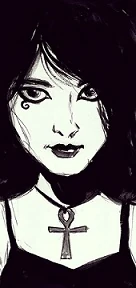The Broken Communion paths changed the most over the course of revising the Paths. The Path of Death integrated with the idea of "Ghosts of Communion," which became increasingly necessary over time as the idea of "haunted" broken communion spaces became more concrete. Obviously, if there were "ghosts" in regions of twisted psionic energy, then "death" could command them or interact with them. As such, it gained a whole mess of new miracles, and that made me ponder new miracles for other Paths.
The Path of Death is the source of at least two Broken Communion cults: the Asrathi death cult and Domen Khemet, the Ranathim Death Cult. Naturally, a single path can spawn multiple cults (and a cult could potentially span multiple paths).
You can see the revised version of the Path of Death here.
Morbid Thoughts
I tend to see the Path of Death as the most coveted of the Broken Communion paths. If you're a Dark Sorcerer of Zathare or the Cult of the Mystical Tyrant, I imagine you may well want to command the powers of Death itself! Those who master the path might try to use it to find some form of immortality, or bring back the dead, or destroy their foes; other than the last, though, it tends to be an illusion, a false promise: the Path of Death destroys, it doesn't preserve or restore.
Similarly, it's the only path to currently have more than one cult dedicated to it, and I see other people coming up with cults dedicated to it too. I think that's natural: Death is a profound part of the life experience: the inevitable ending of it, as well as wondering "what comes next?" People will seek to master or placate that power, to survive a little longer.
The Path of Death emphasizes Broken Communion as "haunting and destructive." If you play up the Path of Death in your campaigns, then Broken Communion becomes a region of ghosts, dark gods and high weirdness. You end up with haunted ships, desolate wastelands and dead planets, with your character acting as psychopomp or necromancer, understanding these areas on a deeper level. I highly recommend reviewing the Ghosts of Broken Communion if you intend to make the Path of Death central to your campaign.
I also think how you picture Death says a lot about how you picture the morality of Broken Communion. If Death is "the greatest evil," and hauntings must be purged, then Broken Communion is "Super-evil." After all, mystical tyrants messing with Death are messing with powers they cannot understand or control! On the other hand, if you see the Path of Death as tragic, and those who follow it as psychopomps who bring comfort to the fallen and sooth these wounded places, then Broken Communion might be weird or tragic.
I won't talk much about gender with the paths of Broken Communion, because those paths tend to be more about large, inhuman, cosmic concepts that defy gender. How can you give gender to Death? I tend to default to the masculine pronoun, because I subscribe the old school of "masculine pronouns as genderless pronouns when 'it' is too dehumanizing;" I definitely don't mean to imply that no women walk the Path of Death, because I imagine they do. The "witch cats" of the Asrathi are, in my mind, feminine and those who follow their Deathwalking Cult tend to be feminine.


No comments:
Post a Comment
Note: Only a member of this blog may post a comment.